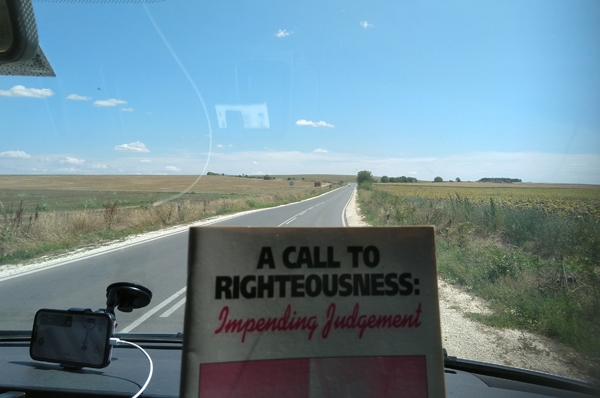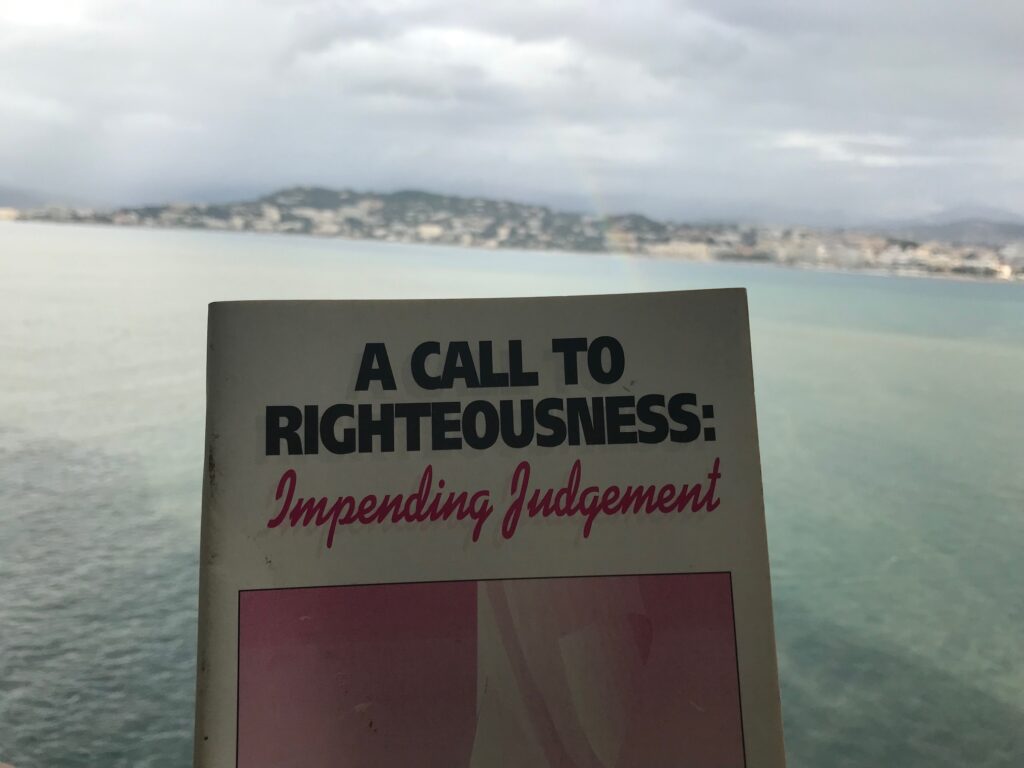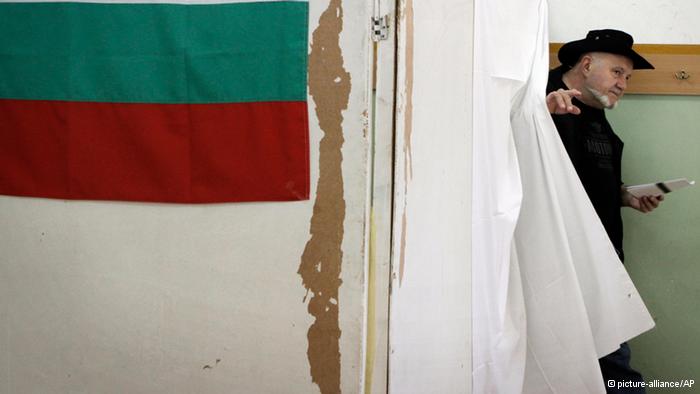365 Daily

In 1999, Dony and Kathryn established Cup & Cross Ministries International with a vision for restoration of New Testament theology and praxis. Today they have over 50 years of combined commitment to Kingdom work. This book invites you to spend a few moments each day on the field sharing their experiences of serving as pastors, evangelists, chaplains, consultants, church trainers, researchers, missionaries and educators of His Harvest around the globe.
Day 175 of the Revival
On day 175 of our Revival, I drove by a building close to our ministry’s home location and it caught my eye. Newly built, large enough, specious parking, perfect location easily reachable from at least three large city regions. An ideal place to hold our large revival meetings in my human perception. Quite naturally, I stopped the car in front of the beautiful gate and began telling the Lord how great would it be to continue the revival here. My reasons were many. No need to travel hundreds of miles to just preach one time, spend the night in strange places, walk in the ankle-deep mud-covered streets of slums and ghettos just to reach a soul. They could all come here, park, gather, worship, hear the Gospel, be saved, healed and delivered. The same way we had seen already in the revival for almost 200 days in a row. My heart’s thoughts were shut down by one brief word from the Lord: I did not choose to have it THIS way…

Reflections on a 200-day Revival
- Creative developing of fasting, prayer and giving of alms, all commanded by Jesus Himself as a regular expression of our faith (Gr. оταν = when you pray, fast, give), is the prerequisite for every Spirit-led revival. On the third day of our 10-day fasting, God used a child to revive our dead Volvo, which no mechanic in a radius of 200 miles could crank for over 6 months.
- The church that forced-left the building during the pandemic, has now returned to multimillion-dollar buildings where God did not choose to start a 200-day Revival. And even when He did, the move was shut down for lack of parking space or nightly supervision. In all actuality, a church building is a result of a revival, its finish and its end. An association with a place, address or location is a sign of its centralized settlement. It was the forced getting-out of a church building (as in Acts 7) that caused the Great Azusa Revival to emerge as a grass-root movement engraved in the streets of LA.
- Revival must emerge from the Desire and Will of God in order to be supernaturally visited by the Power of His Glory! It cannot be approached as a man-made multiplication initiative, be it local, national or globally dimensioned. It is not a project to involve people, but a spiritual tsunami of power, authority and anointing that invites a prophetic projection of what God desires for eternity and not merely what man needs in the now.
- When the now and then align, revival sparks. When the now has lost its sight on eternity, revival is long done and gone. The remain is but a motion imitating the wave of the Spirit Who has already moved to other more receptive spiritual trenches and valleys of humbleness. It is these societal peripheries and spiritual layers that God visits first with Revival before proceeding to the center of religious life. Meaning, the Heart of God for Revival is not in a religious center. As a matter of fact, any association with external centralized governing denies God’s centrality in what the Spirit wills from His Church. A man cannot vanquish the ocean and cosmos of space!
- We can win no soul Christ has not already won at the Cross! We should not try to empty hell to fill Heaven, lest we end up in hell ourselves.
A final word to fundraisers who turn revival into a business-like know-how: Can’t buy God’s love!
A Call to Righteousness over the Road Ahead

Global Mission In Pentecostal Perspective
113 Murray W. Dempster, Byron D. Klaus and Douglas Petersen, eds., Called & Empowered: Global Mission in Pentecostal Perspective (Peabody, MA: Hendrickson Publishers, 1991), 321 pp. $14.95 paper. Reviewed by L. Grant McClung, Jr. Who has the answer to what Pentecostals believe about mission and the description of how they go about doing mission? Coming out of a sense of urgency that caused them to “act now and theologize later,” Pentecostals have been known more for action than reflection. Identifying who the Pentecostals were and how they did the job was a task largely left up to sympathizers from groups such as the Church Growth Movement. Other outside observers, however, were not always so sympathetic. This book is a statement by Pentecostals about Pentecostal missions, a move toward what I have called a “Decade of Self-Definition in the 1990s.” What has emerged since the mid 1980s are signs of a budding “pentecostal missiology,” a development exemplified in this volume. Readers of this excellent new contribution will find that Pentecostals have a broader understanding of wholistic mission issues than the supposed limited agenda of evangelism/church planting via the supernatural. This collection of twelve articles–all from Assemblies of God authors–and three “outside observer” responses has something to say about biblical/theological dimensions, the integration of gospel and culture, response to non-Christian religions, and missiological strategy. It reads well as a text (which I am using) or as a pre-study tool, for example, for a field conference or consultation devoted to understanding the Pentecostal/Charismatic contribution to world evangelization. The three editors are professors at Southern California College in Costa Mesa, California, a Christian liberal arts college sponsored by the Assemblies of God, and are also involved in Latin America ChildCare, an Assemblies of God ministry to underprivileged children in sixteen Latin American countries. The editors introduce each of the five sections of the book with a rationale for the theme of the section and a brief synopsis of each chapter in the section. These sectional introductions give an overall conceptual coherence to the volume, reducing the choppiness and unevenness that often attend multi-authored anthologies. Gordon Fee opens the first section on “Biblical and Theological Dimensions of Global Mission in the Pentecostal Tradition” with a chapter which aims to demonstrate that the roots of the Pentecostal conviction about the global mission of the church are to be found in Jesus’ proclamation of the kingdom of God. In the next chapter, 1 114 Murray Dempster utilizes the concept of the kingdom of God as an integrating center in the development of a wholistic Pentecostal theology which features evangelism, social service and social action. Douglas Petersen in the third chapter of this section adopts and modifies “the hermeneutical circle” of Latin American liberation theologians in order to promote a Pentecostal praxis which applies Jesus’ message of the kingdom within the context of the Third World. Section two focuses on “The Emerging Pentecostal Integration of Gospel and Culture” and features chapters written by Everett Wilson, Augustus Cerillo, Jr., and Del Tarr. Wilson analyzes the phenomenal growth of Pentecostalism in Latin America from a functional perspective, identifying the changing social conditions in Latin culture which encouraged indigenous, national Pentecostal leaders to create “a church of the people.” Cerillo identifies the issues that Pentecostals face in light of the ever-increasing global trend of urbanization, and offers some pertinent suggestions for formulating effective urban ministries. In rounding out this section, Tarr develops a model of communication for preaching the gospel across the different cultural regions of the globe. The issue of gospel and culture is taken up again in section three but the issue is analyzed from the perspective of differing worldviews. Each author describes the worldview under investigation in his chapter from his viewpoint as a participant: Peter Kuzmic analyzes the Marxist worldview, Sunday Aigbe analyzes the worldview of tribal people groups and Sobhi Malek analyzes the Muslim worldview. Given the breakup of the former Soviet Union subsequent to the writing of his chapter, Kuzmic sho.wed great insight in noting: “Anything written about the ‘communist world’ today should be written in pencil. All across Eastern Europe and in the Soviet Union monumental changes are taking place at a breathtaking speed and in most dramatic and unpredictable ways” (143-44). Even though sweeping changes have occurred in the Communist bloc countries, Kuzmic’s study still provides a goldmine of information in understanding what is happening in that part of the world. “Pentecostals and Current Missiological Strategies” is the topic of section four. A chapter by Gary McGee provides a descriptive historical overview of the multiple mission strategies that Pentecostals have used in this century. A jointly-written chapter by Byron Klaus and Loren Triplett documents the historical connection between non-formal/informal national leadership programs and the mushrooming growth of Pentecostalism, warns Pentecostals about their newly found reliance on formal structures of national leadership development and calls for a renewed commitment to indigenous leadership development “in ministry.” Missiologist Larry Pate, in the last chapter in the strategies section, describes the emergence of the 2 115 “two-thirds world missions movement” and assesses its implications for Pentecostal missions efforts. Pate makes a compelling case that theological and practical reflection on the implications of the global shift embodied in the two-thirds world missions movement is the most important strategic issue facing Pentecostal missions today. The fifth and final section of the book provides “Views from Outside” the Pentecostal movement, and according to the editors, the chapters in this section “stress the importance of Pentecostals learning to listen to the broader church as part of its missiological activity” (xviii). Pentecostal mission effort is evaluated from a Church Growth perspective by Peter Wagner, from an ecumenical perspective by Jeffrey Gros, FCS, and from a Third Wave perspective by Charles Kraft. These chapters, designed to provide “dialogical feedback,” are stimulating to read and insightful in both their positive appraisals and constructive criticisms. Hopefully, Called & Empowered will be expanded and revised in a subsequent edition to include a broader participation of missions practice and reflection from a wider variety of Pentecostal and Charismatic missions ministries, along with more contributions from women (all the authors are male) and voices from the “southern world” (only three of twelve essays are from non-North Americans). The book, however, is well-researched and highly readable for those seeking to look through the window into the self-understanding of Pentecostals and their responsibility in world evangelization. Even the casual observer of this tradition would agree that the energy Pentecostals expend in world missions activity flows out of the belief that Pentecostals are Called & Empowered. L. Grant McClung, Jr., is Coordinator of Research and Strategic Planning for the Church of God World Missions and Associate Professor of Missions and Church Growth at the Church of God School of Theology in Cleveland, Tennessee. 3
A Call to Righteousness over Italy

Bulgaria: What to Watch for in the November 14 Elections
Although the third for the year, on November 14 for the first time the elections will be 2 in 1 – for president and MPs. The vote is taking place at the peak of the fourth wave of coronavirus in Bulgaria and anti-epidemic measures will again be observed, and the number of those who voted with a mobile ballot box will be clear on election day.
For the second time, the voting in the sections with 300 and more voters will be only with machines, but for both votes the voting procedure will be with one device, and it will be necessary to indicate what to vote for and wait for the printing of two receipts. Therefore, it is expected that the process will be slower, and if the cases of patients in the coming days increase – this will affect the turnout.
In front of the voters
The third election of the year will be held at the peak of the fourth wave of the coronavirus epidemic, which may be a cause for concern among some eligible voters. For now, there will be no stricter anti-epidemic measures in the polling stations and they will remain known until now – wearing masks, disinfection, distance and frequent ventilation in the premises. From the previous two votes it cannot be concluded that the incidence will be denied by voters, as on April 4, when the peak of the third wave was, voter turnout was 50.61%, while on July 11, when there were few registered cases – only 42.19% .
Quarantined voters will be able to ask to vote with a mobile ballot box at the address where they are isolated, even on election day. It would be an obstacle if by the day of the vote in a given settlement there is no section for quarantined, as a condition to have only 10 applications submitted before. However, the Central Election Commission did not know whether it would be possible to open so many quarantined sections in recent weeks.
For the first time this year, the elections will be 2 in 1 – for president and MPs, which could lead to delays and queues in some sections. In the sections with 300 and more voters, the voting is only with machines, and the voting time is expected to be 5 minutes again.
There are two points that a voter using a device should be aware of. The first is at the beginning, when the machine asks which type of election the voter wants to vote for and whether for both – he/she can mark once and by continuing, confirm, after which he/she has no right to correction. The second is when printing the segments with the choice at the end – if the voter has exercised his/her right to vote in both votes, he/she must wait for the machine to print two receipts – one short and one longer, and pull them out after hearing a beep. If it does so while printing, the machine may lock.
The voter will also have a problem if he/she decides to take pictures of how they vote, as the recording of the vote is prohibited and the sanction is BGN 1,000.
Possible problems for the election commissions
There seem to be two main challenges for sectional election commissions – one is related to the machines and the other is to the counting of the voting receipts.
The problems with the machines can be of different nature – technical malfunctions, errors in the lists as on April 4 in Veliko Tarnovo, when there were exchanged names and numbers in one of the candidate lists, errors in cleaning, which can only be done with alcohol, etc. . A technician will be available, but if the fault is not rectified, a paper ballot will be put to the vote following a decision by the district or central commission.
Difficulty and delays in reporting the results would be caused by the decision to count all machine voting receipts, which were taken by the Central Election Commission but revoked by the Supreme Administrative Court. The commission should now determine in how many and in which sections the control receipts should be counted, and the result will be taken from the protocol printed by the machine, and the result of the control count will not be entered in the protocol.
However, the count will slow down the section commissions where it is done. After the end of the election day, the commissions will have to open the box with the receipts, divide into two piles those for the presidential and those for the parliamentary vote and then count, without taking into account the preferences for MPs. According to experts, voluntary or unintentional human errors are possible during the counting, as well as manipulations by destroying part of the receipts. This will certainly delay the transmission of the results to the district election commissions.
What made us Pentecostal?
![article-0-14AD215E000005DC-994_634x422[1]](https://cupandcross.com/wp-content/uploads/2014/01/article-0-14AD215E000005DC-994_634x4221-300x199.jpg) Pentecostalism is a message for standing fast till the end. As Pentecostals, we preached this message before we had a sermon outline.
Pentecostalism is a message for standing fast till the end. As Pentecostals, we preached this message before we had a sermon outline.
We went without knowing. We prayed without ceasing. We prophesied without seeing in the physical or even purposefully refusing to reckon with it.
We preached without a season, for preaching was the vibe of our ministry and the heartbeat of our churches. We preached because we had a testimony. We did not know how to say it, but we had something to say.
We did not know how to write a sermon, or a theological exposition, or an exegetical definition, or a leadership proposition, but we preached because we had an experience that NO sermon could recreate and no message could deliver.
We had met God upon the mountain and that personal meeting, that date with destiny, that divine appointment had become our source of life everlasting. And this is what made us Pentecostal.
Evangelism and World Missions
Empowered by the vision for a continuous revival within the church of the 21st century, we have chosen to make the mission of our work this one statement: We help churches grow.
One of the approaches we have taken to accomplish this ministry goal is Evangelism and World Missions:
- We have ministered for over 30 years now on three continents, 25 U.S. states, Canada and Mexico (Map of our global ministry)
- We have spent seven consecutive years in missionary work in Bulgaria ministering to over 300 local congregations (Map of our ministry in Bulgaria)
- Since 1990, we have helped in the planting and team training of over 25 churches in Bulgaria as well as the Bulgarian congregations in Chicago, Houston, Las Vegas, San Francisco, Atlanta, London, Spain, Cyprus and Palma de Mallorca
Beside personal presence and team building strategies, we implement the media in virtually every approach of ministry. We have published several research monographs as well as film series about our ministry work. Our team holds a weekly TV program called the Bible Hour. (Learn how we help churches build their own and unique web presence)
See also how we help churches grow through:
What Happens in Vegas is Written in Heaven
 We spent Palm Sunday together with the Bulgarian evangelical community of Las Vegas. The Bulgarian Diaspora in the most famous Nevada city has grown rapidly in the past few years now reaching several thousand immigrants who have established a prominent presence in the local community. The latest additions to the area are a Bulgarian store, a Bulgarian restaurant and of course a newspaper for the Bulgarians in Vegas.
We spent Palm Sunday together with the Bulgarian evangelical community of Las Vegas. The Bulgarian Diaspora in the most famous Nevada city has grown rapidly in the past few years now reaching several thousand immigrants who have established a prominent presence in the local community. The latest additions to the area are a Bulgarian store, a Bulgarian restaurant and of course a newspaper for the Bulgarians in Vegas.
Naturally, an evangelical church is being formed in the existing Bulgarian community. These are not only people who have ties with the evangelical churches in Bulgaria, but their families and representatives of second generation immigrants as well.
We were blessed to receive a cordial invitation to minister to them on our way back from the West Coast. Arriving in town, we held a Bible study on Friday and then preached at the beautiful Palm Sunday service organized by the Bulgarian evangelical believers of Las Vegas. As we prayed with the people for the remaining of the warm Sunday evening, preaching Salvation in Sin City became more than a slogan. This world claims that “What happens in Vegas stays in Vegas”, but what happened in the Bulgarian evangelical church in Vegas on Palm Sunday is written in Heaven.









